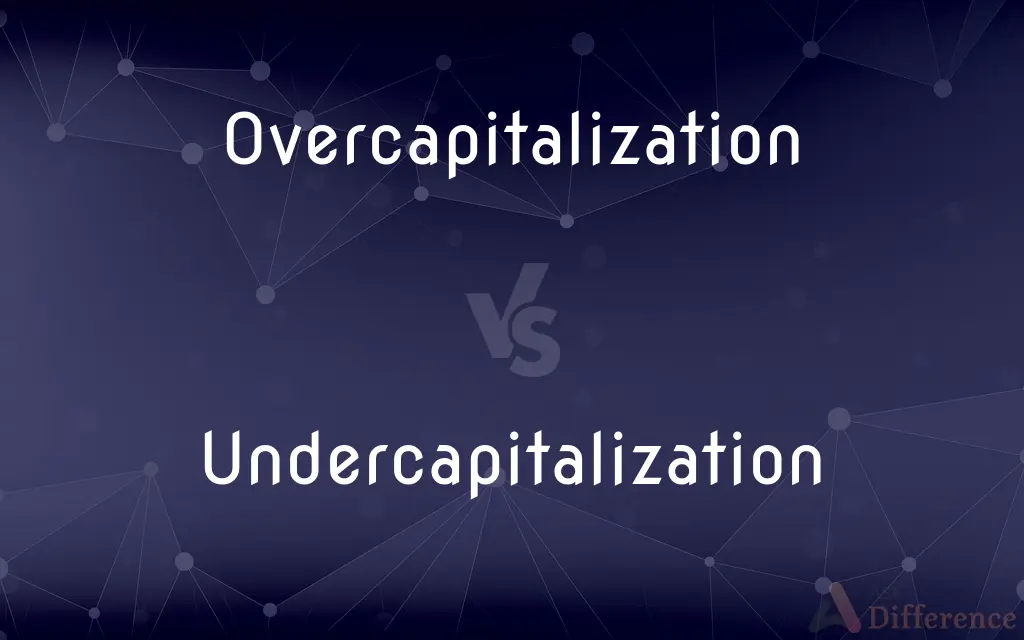Overcapitalization vs. Undercapitalization — What's the Difference?
By Tayyaba Rehman — Updated on September 30, 2023
Overcapitalization is when a company’s actual capital exceeds its real value, affecting profitability. Undercapitalization is when a company lacks sufficient capital to sustain its operations, risking solvency.

Difference Between Overcapitalization and Undercapitalization
Table of Contents
ADVERTISEMENT
Key Differences
Overcapitalization and undercapitalization represent two contrasting financial states of a company. Overcapitalization occurs when a company's actual capital, the combination of its debt and equity, exceeds its real enterprise value or its earning capacity. This discrepancy often leads to reduced profitability and diminished return on investment, as the business may struggle to generate adequate returns to justify its capital structure. It generally occurs due to excessive borrowing, over-issuance of shares, or overvaluation of assets.
Conversely, undercapitalization refers to the situation where a company does not have enough capital to conduct regular business operations efficiently. This condition can potentially lead to the risk of insolvency, as the company might struggle to meet its financial obligations. Undercapitalization typically results from inadequate initial investment, inability to access additional funds, or higher-than-expected operational costs.
Overcapitalization typically demands corrective measures such as restructuring of capital, which might include paying off debt or buying back shares, to bring the capital back in alignment with the company’s real value. This realignment is crucial for maintaining investor trust and ensuring the longevity of the company, as prolonged overcapitalization can damage a company’s market reputation and investor relations.
Undercapitalization, on the other hand, often requires infusion of additional funds, either through equity or debt, to sustain business operations. Addressing undercapitalization is vital for a company's survival and growth, as inadequate capital can hinder operational efficiency, limit business expansion, and eventually lead to bankruptcy if not rectified in time.
In essence, while overcapitalization necessitates restructuring and realignment of capital to actual value, undercapitalization demands an infusion of funds to bolster operational capacities, both critical for maintaining equilibrium and ensuring the financial health of a company.
ADVERTISEMENT
Comparison Chart
Definition
Excess capital compared to real enterprise value.
Insufficient capital to sustain regular operations.
Implication
Reduced profitability and ROI.
Risk of insolvency and operational hindrance.
Occurrence
Due to over-borrowing or overvaluation of assets.
Due to inadequate initial investment or access to funds
Resolution
Restructuring of capital, debt repayment.
Infusion of additional funds, debt or equity.
Impact
Can damage market reputation and investor relations.
Can lead to bankruptcy if not addressed.
Compare with Definitions
Overcapitalization
Necessitates capital restructuring to realign with actual value.
The management considered debt repayment as a solution to overcapitalization.
Undercapitalization
The condition of having insufficient capital to carry out business operations smoothly.
The startup faced operational hurdles due to undercapitalization.
Overcapitalization
Leads to diminished profitability due to misalignment of capital and value.
Overcapitalization affected the company's returns, causing concern among investors.
Undercapitalization
Requires infusion of capital to ensure operational continuity and business expansion.
To combat undercapitalization, the company sought new investors.
Overcapitalization
A state where a company’s actual capital exceeds its real value.
The company, facing overcapitalization, initiated a share buyback program.
Undercapitalization
Can lead to solvency risks if the company cannot meet its financial obligations.
Persistent undercapitalization pushed the company closer to bankruptcy.
Overcapitalization
Typically occurs due to excess borrowing or overvaluation of assets.
Due to overcapitalization, the company struggled to generate adequate returns on investments.
Undercapitalization
Often results from inadequate initial investment or limited access to additional funds.
Lack of access to credit markets led to the firm’s undercapitalization.
Overcapitalization
Can impact market reputation and investor relations negatively.
Prolonged overcapitalization raised doubts about the company's financial prudence.
Undercapitalization
Hinders operational efficiency and limits growth opportunities.
Undercapitalization restrained the company from exploring lucrative markets.
Overcapitalization
To cause (a company) to have an excess amount of capital.
Undercapitalization
Under-capitalization refers to any situation where a business cannot acquire the funds they need. An under-capitalized business may be one that cannot afford current operational expenses due to a lack of capital, which can trigger bankruptcy, may be one that is over-exposed to risk, or may be one that is financially sound but does not have the funds required to expand to meet market demand.
Overcapitalization
To estimate the value of (property) too highly.
Undercapitalization
The condition of lacking sufficient capital to perform normal business operations.
Overcapitalization
The state of being overcapitalized.
Undercapitalization
(finance) Insufficient capitalization
Overcapitalization
(business) too much capitalization (the sale of more stock than the business warrants)
Common Curiosities
Can Overcapitalization affect investor relations?
Yes, prolonged Overcapitalization can damage a company's reputation and strain investor relations.
What causes Undercapitalization?
Undercapitalization usually results from inadequate initial funding or an inability to access additional funds.
What does Overcapitalization imply?
Overcapitalization implies a company has more capital than its real value, impacting profitability and ROI negatively.
Can Undercapitalization lead to bankruptcy?
Yes, if Undercapitalization is not addressed, it can lead to insolvency and potentially to bankruptcy.
Can Undercapitalization limit business expansion?
Yes, Undercapitalization can restrict a company's ability to invest in new opportunities and hinder business expansion.
How can Overcapitalization be corrected?
Overcapitalization can be corrected through capital restructuring, like debt repayment or share buybacks.
Is Overcapitalization related to overvaluation of assets?
Yes, Overcapitalization can occur due to overvaluation of assets or excessive borrowing.
Does Overcapitalization impact return on investment (ROI)?
Yes, Overcapitalization usually results in diminished ROI due to misalignment of capital and value.
How does Undercapitalization affect a company?
Undercapitalization can hinder business operations, create solvency risks, and limit growth opportunities.
How is Undercapitalization resolved?
Undercapitalization is typically resolved by infusing additional capital, either through debt or equity.
Is Undercapitalization common in startups?
Yes, startups often face Undercapitalization due to inadequate initial investments and challenges in securing additional funds.
How does Overcapitalization affect shareholder value?
Overcapitalization can erode shareholder value by reducing profitability and diminishing returns on investment.
What is a common solution for Undercapitalization?
A common solution for Undercapitalization is securing additional funds through loans or investments.
What factors lead to Overcapitalization?
Overcapitalization arises typically from excessive borrowing, over-issuance of shares, or asset overvaluation.
Can Overcapitalization be prevented?
Prudent financial management, realistic asset valuation, and balanced borrowing can help prevent Overcapitalization.
Share Your Discovery

Previous Comparison
Collate vs. Compile
Next Comparison
Subculture vs. CountercultureAuthor Spotlight
Written by
Tayyaba RehmanTayyaba Rehman is a distinguished writer, currently serving as a primary contributor to askdifference.com. As a researcher in semantics and etymology, Tayyaba's passion for the complexity of languages and their distinctions has found a perfect home on the platform. Tayyaba delves into the intricacies of language, distinguishing between commonly confused words and phrases, thereby providing clarity for readers worldwide.
















































